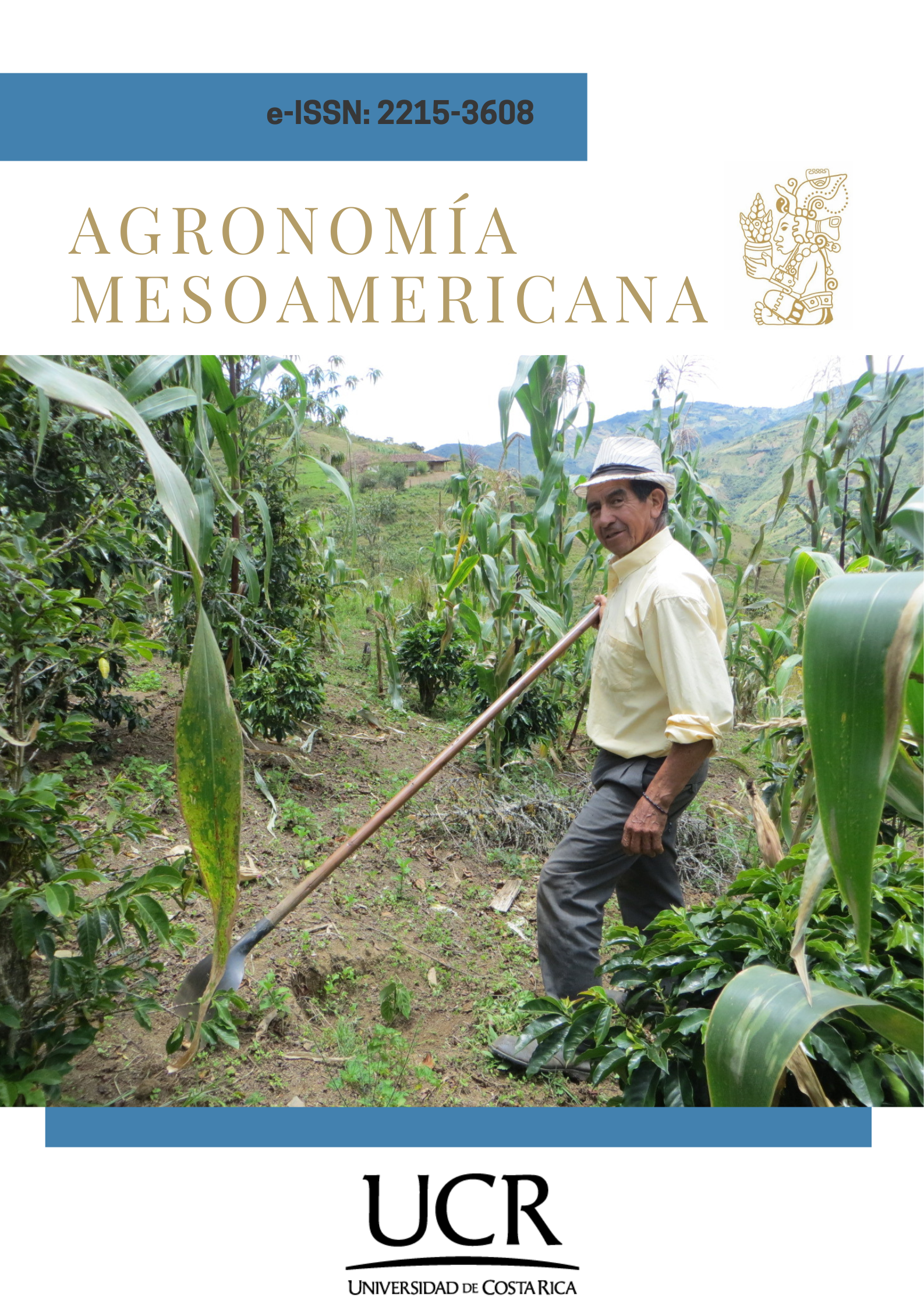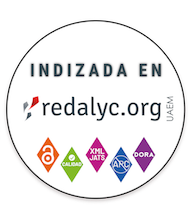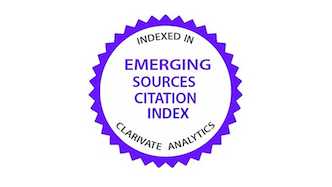Almacenamiento de carbono orgánico en el suelo en diferentes sistemas agroforestales en asocio con café en Nariño, Colombia
DOI:
https://doi.org/10.15517/am.2024.59765Palabras clave:
Servicios ecosistémicos, agroforestería, conservación de suelos, CoffeaResumen
Introducción. Las actividades antropogénicas son una de las causas del aumento de la temperatura global, lo que afecta los procesos agroambientales, ecológicos y socioeconómicos. Las contribuciones de los sistemas de producción agrícola en la captura y almacenamiento de gases de efecto invernadero han sido poco estudiadas, pero la literatura indica que la inclusión de árboles en las fincas es una opción para capturar y almacenar algunos gases de efecto invernadero. Objetivo. Evaluar la relación entre la diversidad florística y estructural de los sistemas de producción de café y el carbono orgánico almacenado en el suelo (COS). Materiales y métodos. El estudio se llevó a cabo en durante el período 2019-2020, en tres localidades Sandoná, San Pablo y Buesaco, Nariño-Colombia. Se visitaron doce agroecosistemas con café, donde se evaluó los índices de Shannon-Weiner y Simpson, la densidad de árboles y el análisis completo del suelo con muestras a 30 cm de profundidad. Un análisis de varianza y componentes principales fueron suficientes para el análisis de la información. Resultados. El COS no presentaron diferencias estadísticas (p > 0,05), el cual varió entre 38,55 Mg ha-1 en el arreglo de café a pleno sol en Buesaco y 96,63 Mg ha-1 en el arreglo de café con misceláneas en el mismo municipio, el cual presentó la mayor diversidad de especies. Conclusiones. Se demostró que, el cultivo de café en asocio con sistemas agroforestales (T3 y T4) con mayor diversidad y abundancia de especies, supera el carbono acumulado en el suelo en comparación con el monocultivo de café (80,43 Mg ha-1 vs 58,32 Mg ha-1, respectivamente); esta diversificación provee de bienes y servicios a la familia y al ambiente al contribuir a la mitigación del cambio climático.
Descargas
Citas
Aguilar, A., & Guharay, F. (2002). Cómo realizar un diagnóstico productivo en nuestro cafetal (Serie Cuadernos de Campo). Centro Agronómico Tropical de Investigación y Enseñanza.
Alvarado, J., Andrade, H. J., & Segura, M. (2013). Almacenamiento de carbono orgánico en suelos en sistemas de producción de café (Coffea arabica L.) en el municipio del Líbano, Tolima, Colombia. Colombia Forestal, 16(1), 21–31. https://doi.org/10.14483/udistrital.jour.colomb.for.2013.1.a02
Andrade, H. J., Segura, M., & Somarriba, E. (2022). Above-ground biomass models for dominant trees species in cacao agroforestry systems in Talamanca, Costa Rica. Agroforestry Systems, 96(1), 787–797. https://doi.org/10.1007/s10457-022-00741-y
Ávila, G., Jimenes, F., Beer, J., Gómez, M., & Ibrahim, M. (2001). Almacenamiento, fijación de carbono y valoración de servicios ambientales en sistemas agroforestales en Costa Rica. Agroforestería de las Américas, 8(30), 32–35.
Burbano-Orejuela, H. (2016). El suelo y su relación con los servicios ecosistémicos y la seguridad alimentaria. Revista de Ciencias Agrícolas, 33(2), 117–124. http://dx.doi.org/10.22267/rcia.163302.58
Burbano-Orejuela, H. (2018). El carbono orgánico del suelo y su papel frente al cambio climático. Revista de Ciencias Agrícolas, 35(1), 82–96. http://dx.doi.org/10.22267/rcia.183501.85
Canchala, T., Ocampo-Marulanda, C., Alfonso-Morales, W., Carvajal-Escobar, Y., Cerón, W. L., & Caicedo-Bravo, E. (2022). Techniques for monthly rainfall regionalization in southwestern Colombia. Anais Da Academia Brasileira De Ciências, 94(4), Article e20201000. https://doi.org/10.1590/0001-3765202220201000
Carvajal, A., Feijoo, A., Quintero, H., & Rondón, M. (2009). Carbono orgánico del suelo en diferentes usos del terreno de paisajes andinos colombianos. Revista de la Ciencia del Suelo y Nutrición Vegetal, 9(3), 222–235. http://dx.doi.org/10.4067/S0718-27912009000300005
Cerón, W., Kayano, M. T., Andreoli, R. V., Canchala, T., Carvajal-Escobar, Y., & Alfonso-Morales, W. (2021). Rainfall Variability in Southwestern Colombia: Changes in ENSO-Related Features. Pure and Applied Geophysics, 178, 1087–1103. https://doi.org/10.1007/s00024-021-02673-7
Criollo Escobar, H., Lagos Burbano, T. C., Bacca Ibarra, T., & Muñoz Belalcazar, J. A. (2016). Caracterización de los sistemas productivos de café en Nariño, Colombia. Revista U.D.C.A Actualidad & Divulgación Científica, 19(1), 105–113. https://doi.org/10.31910/rudca.v19.n1.2016.260
Delgado Vargas, I. A., Daza Castillo, J. M., Luna Cabrera, G. C., Leonel, H. F., & Forero Peña, L. A. (2016). Cuantificación de carbono radical Morella pubescens (Humb. & Bonpl. ex Willd.) Wilbur en dos agroecosistemas (Nariño, Colombia). Colombia Forestal, 19(2), 85–93. https://doi.org/10.14483/udistrital.jour.colomb.for.2016.2.a06
Delgado-Vargas, I., Ballesteros Possú, W., & Arellano Chungana, V. (2022). Agrobiodiversidad de leñosas multipropósito en sistemas productivos cafeteros. Revista de Investigación Agraria y Ambiental, 13(2), 67–80. https://doi.org/10.22490/21456453.4741
Delgado-Vargas, I. A., Leonel, H. F., Molina-Moreno, Á. A., Ojeda Chávez, N., & Pinta Paz, P. A. (2022). Ethnoedaphology as an integrating process between academy and peasant knowledge in the productive system of coffee (Coffea arabica L.) of Southwestern Colombia. Agricultural Sciences, 13(10), 1013–1030. https://doi.org/10.4236/as.2022.1310062
Forsythe, W. (1975). Manual de laboratorio: Física de suelos. Instituto Interamericano de Cooperación para la Agricultura.
Gamarra Lezcano, C. C., Díaz Lezcano, M. I., Vera de Ortíz, M., Galeano, M. del P., & Cabrera Cardús, A. J. N. (2018). Relación carbono-nitrógeno en suelos de sistemas silvopastoriles del Chaco paraguayo. Revista Mexicana de Ciencias Forestales, 9(46), 4–26. https://cienciasforestales.inifap.gob.mx/index.php/forestales/article/view/134
Goçalves Tonucci, R., Falconeres Vogado, R., Dias Silva, R., Fernandes Franco, R. C., Oda-Souza, M., & Antunes de Souza, H. (2023). Agroforestry system improves soil carbon and nitrogen stocks in depth after land-use changes in the Brazilian semi-arid region. Revista Brasileira De Ciência Do Solo, 47, Article e0220124. https://doi.org/10.36783/18069657rbcs20220124
Gómez Cardozo, E., Rousseau, G. X., Celentano, D., Fariñas Salazar, H., & Gehring, C. (2018). Efecto de la riqueza de especies y estructura de la vegetación en el almacenamiento de carbono en sistemas agroforestales de la Amazonía, Bolivia. Revista de Biología Tropical, 66(4), 1481–1495. http://dx.doi.org/10.15517/rbt.v66i4.32489
Hergoualc’h, K., Blanchart, E., Skiba, U., Hénaultf, C., & Harmanda, J.-M. (2012). Changes in carbon stock and greenhouse gas balance in a coffee (Coffea arabica) monoculture versus an agroforestry system with Inga densiflora, in Costa Rica. Agriculture, Ecosystems and Environment, 148, 102–110. https://doi.org/10.1016/j.agee.2011.11.018
Hernández Núñez, H. E., Andrade, H. J., Suárez Salazar, J. C., Sánchez, J. R., Gutiérrez, D. R., Gutiérrez García, G. A., Trujillo Trujillo, E., & Casanoves, F. (2023). Almacenamiento de carbono en sistemas agroforestales en los Llanos Orientales de Colombia. Revista de Biología Tropical, 69(1), 352–368. http://dx.doi.org/10.15517/rbt.v69i1.42959
Holdridge, L. R. (1982). Life zone ecology. Tropical Science Center.
Intergovernmental Panel on Climate Change. (2023). AR6 synthesis report: Climate Change 2023. https://www.ipcc.ch/report/ar6/syr/
Instituto Colombiano de Normas Técnicas y Certificación. (2006). NTC 5402 calidad de suelo. Determinación del azufre disponible. https://tienda.icontec.org/wp-content/uploads/pdfs/NTC5402.pdf
Instituto Geográfico Agustín Codazzi. (2004). Estudio general de suelos y zonificación de tierras departamento de Nariño. Escala 1: 100000. https://metadatos.icde.gov.co/geonetwork/srv/api/records/14145369
Instituto Geográfico Agustín Codazzi. (2006). Métodos analíticos del laboratorio de suelos (6a ed.). Imprenta nacional de Colombia.
Laban, P., Metternicht, G., & Davies, J. (2018). Biodiversidad de suelos y carbono orgánico en suelos: cómo mantener vivas las tierras áridas. Unión Internacional para la Conservación de la Naturaleza. https://doi.org/10.2305/IUCN.CH.2018.03.es
Leonel, H. F., Delgado-Vargas, I. A., Molina-Moreno, A. A., & Cadena-Pastrana, Á. M. (2023). Tipificación de fincas cafeteras para la implementación de tecnologías de adaptación al cambio climático, Municipio de Buesaco (Nariño, Colombia). Información Tecnológica, 34(3), 31–42. https://dx.doi.org/10.4067/S0718-07642023000300031
MacDicken, K. G. (1997). Guide to monitoring carbon storage in forestry and agroforestry projects. Winrock International Inst. for Agricultural Development. https://www.osti.gov/biblio/362203
Ontong, N., Poolsiri, R., Diloksumpun, S., Staporn, D., & Jenke, M. (2023). Effects of tree functional traits on soil respiration in tropical forest plantations. Forests, 14(4), Article 715. https://dx.doi.org/10.3390/f14040715
Organización de las Naciones Unidad para la Alimentación y la Agricultura. (2002). Captura de carbono en los suelos para un mejor manejo de la tierra (Informes sobre recursos mundiales de suelos 96). https://www.fao.org/3/bl001s/bl001s.pdf
Pinoargote, M., Cerda, R., Mercado, L., Aguilar, A., Barrios, M., & Somarriba, E. (2017). Carbon stocks, net cash flow and family benefits from four small coffee plantation types in Nicaragua. Trees and Livelihoods, 26(3), 183–198. https://doi.org/10.1080/14728028.2016.1268544
Poveda, V., Orozco, L., Medina, C., Cerda, R., & López, A. (2013). Almacenamiento de carbono en sistemas agroforestales de cacao en Waslala, Nicaragua. Agroforestería en las Américas, 49, 42–50.
Ramos-Prado, J., Romero-Hernández, E., Sánchez-Morales, P., Jiménez-García, D., & Hipólito-Romero, E. (2023). Dimensiones bioculturales y socioeconómicas de la sustentabilidad en sistemas agroforestales diversificados con cacao y vainilla. Revista Mexicana De Ciencias Agrícolas, 14(3), 401–412. https://doi.org/10.29312/remexca.v14i3.3093
R Core Team. (2023). R: A language and environment for statistical computing (R version 4.2.3). R Foundation for Statistical Computing. https://www.R-project.org/
Rodríguez, L., Suárez, J. C., Rodriguez, W., Artunduaga, K. J., & Lavelle, P. (2022). Agroforestry systems impact soil macroaggregation and enhance carbon storage in Colombian deforested Amazonia. Geoderma, 348(10), Article 114810. https://doi.org/10.1016/j.geoderma.2020.114810
Rousseau, G., Deheuvels, O., Celentano, D., Arias, I. R., Hernández-García, L. M., & Somarriba, E. (2021). Shade tree identity rather than diversity influences soil macrofauna in cacao-based agroforestry systems. Pedobiologia, 89, Article 150770. https://doi.org/10.1016/j.pedobi.2021.150770
Ruíz Murcia, F., Gutiérrez Valderrama, J. E., Dorado Delgado, J., Mendoza, J. E., Martínez Zuleta, C., Rojas Laserna, M., Hernández Gaona, D., & Rodríguez Salguero, M. (2015). Nuevos Escenarios de Cambio Climático para Colombia 2011-2100 (3a comunicación). Instituto de Hidrología, Meteorología y Estudios Ambientales, Programa de las Naciones Unidas para el Desarrollo, Ministerio de Medio Ambiente y Desarrollo Sostenible y Departamento Nacional de Planeación y Cancillería. https://www.andi.com.co/Uploads/NUEVOS%20ESCENARIOS%20DE%20CAMBIO%20CLIM%C3%81TICO%20COLOMBIA%202011%20-%202100.pdf
Siles, P., Harmand, J.-M., & Vaast, P. (2010). Effects of Inga densiflora on the microclimate of coffee (Coffea arabica L.) and overall biomass under optimal growing conditions in Costa Rica. Agroforestry Systems, 78, 269–286. https://doi.org/10.1007/s10457-009-9241-y
Somarriba, E., Cerda, R., Orozco, L., Cifuentes, M., Dávila, H., Espin, T., Mavisoy, H., Ávila, G., Alvarado, E., Poveda, V., Astorga, C., Say, E., & Deheuvels, O. (2013). Carbon stocks and cocoa yields in agroforestry systems of Central America. Agriculture, Ecosystems and Environment, 173, 46–57. https://doi.org/10.1016/j.agee.2013.04.013
Somarriba, E., Saj, S., Orozco-Aguilar, L., Somarriba, A., & Rapidel, B. (2024). Shade canopy density variables in cocoa and coffee agroforestry systems. Agroforestry System, 98, 585–601. https://doi.org/10.1007/s10457-023-00931-2
Vega Orozco, G., Ordoñez Espinosa, C. M., Suarez Salazar, J. C., & López Pantoja, C. F. (2014). Almacenamiento de carbono en arreglos agroforestales asociados con café (Coffea arabica L.) en el sur de Colombia. Revista de Investigación Agraria y Ambiental, 5(1), 213–221. https://doi.org/10.22490/21456453.956
Villanueva, C., Ibrahim, M., & Castillo, C. (2023). Enteric methane emissions in dairy cows with different genetic groups in the humid tropics of Costa Rica. Animals, 13(4), Article 730. https://doi.org/10.3390/ani13040730
Xiang, Y., Li, Y., Luo, X., Liu, Y., Huang, P., Yao, B., Zhang, L., Li, W., Xue, J., Gao, H., Li, Y., & Zhang, W. (2022). Mixed plantations enhance more soil organic carbon stocks than monocultures across China: Implication for optimizing afforestation/reforestation strategies. Science of the Total Environment, 821, Article 153449. https://doi.org/10.1016/j.scitotenv.2022.153449

Archivos adicionales
Publicado
Cómo citar
Número
Sección
Licencia
Derechos de autor 2024 Ivan A. Delgado-Vargas, Natalia Benavides Franco

Esta obra está bajo una licencia internacional Creative Commons Atribución-NoComercial-SinDerivadas 4.0.
1. Política propuesta para revistas de acceso abierto
Los autores/as que publiquen en esta revista aceptan las siguientes condiciones:
- Los autores/as conservan los derechos morales de autor y ceden a la revista el derecho de la primera publicación, con el trabajo registrado con la licencia de atribución, no comercial y sin obra derivada de Creative Commons, que permite a terceros utilizar lo publicado siempre que mencionen la autoría del trabajo y a la primera publicación en esta revista, no se puede hacer uso de la obra con propósitos comerciales y no se puede utilizar las publicaciones para remezclar, transformar o crear otra obra.
- Los autores/as pueden realizar otros acuerdos contractuales independientes y adicionales para la distribución no exclusiva de la versión del artículo publicado en esta revista (p. ej., incluirlo en un repositorio institucional o publicarlo en un libro) siempre que indiquen claramente que el trabajo se publicó por primera vez en esta revista.
- Se permite y recomienda a los autores/as a publicar su trabajo en Internet (por ejemplo en páginas institucionales o personales) antes y durante el proceso de revisión y publicación, ya que puede conducir a intercambios productivos y a una mayor y más rápida difusión del trabajo publicado (vea The Effect of Open Access).























